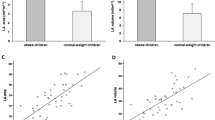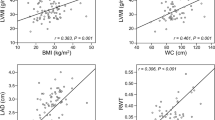Abstract
Obesity (OB) in adults is associated with insulin resistance, hypertension, and left atrial (LA) enlargement. This study aimed to determine the association between LA size and (1) different components of the metabolic syndrome (body mass index [BMI], waist circumference [WC], insulin levels, lipid levels, and blood pressure), and (2) left ventricular (LV) diameters and diastolic function. Data were collected cross-sectionally from 142 healthy adolescent boys age 16.8 ± 2.0 years in 2009. Measurements of BMI, WC, blood pressure, lipid profile, and insulin were performed. Mode M, two-dimensional Doppler echocardiography was performed. Measurements of LA area, LV end diastolic diameter (EDD), end systolic diameter (ESD), posterior wall, interventricular septum (IVS), and shortening fraction were performed. Tisular Doppler of the diastolic mitral annular E wave (DTE) and A wave (DTA) and the ratio of maximal early diastolic filling wave velocity to maximal early diastolic myocardial velocity (E/e′) were recorded. The study group included 38 OB boys (26.8%) and 32 overweight boys (22.5%). Significant univariate association was found between LA area and BMI (r = 0.61), WC (r = 0.56), systolic blood pressure (r = 0.21), insulinemia (r = 0.28), high-density lipoprotein-cholesterol (HDL-C) (r = –0.24), triglycerides (r = 0.20), EDD (r = 0.25), LV posterior wall (r = 0.25), IVS (r = 0.25), DTE (r = 0.27), DTA (r = 0.30), and E/e′ (r = –0.28). Multiple linear regression analysis showed that LA area was associated with BMI (B = 0.61; R 2 = 0.47) adjusted for confounding variables. In adolescents, BMI and WC were significantly associated with LA, suggesting that OB could be associated with LA enlargement as early as adolescence.

Similar content being viewed by others
References
Abhayaratna WP, Seward JB, Appleton CP, Douglas PS, Oh JK, Tajik AJ, Tsang TS (2006) Left atrial size: physiologic determinants and clinical applications. J Am Coll Cardiol 47:2357–2363
Ayer JG, Almafragy HS, Patel AA, Hellyer RL, Celermajer DS (2008) Body mass index is an independent determinant of left atrial size. Heart Lung Circ 17:19–24
Ayer JG, Sholler GF, Celermajer DS (2010) Left atrial size increases with body mass index in children. Int J Cardiol 141:61–67
Barnes ME, Miyasaka Y, Seward JB, Gersh BJ, Rosales AG, Bailey KR, Petty GW, Wiebers DO, Tsang TS (2004) Left atrial volume in the prediction of first ischemic stroke in an elderly cohort without atrial fibrillation. Mayo Clin Proc 79:1008–1014
Cuspidi C, Meani S, Fusi V, Valerio C, Catini E, Sala C, Sampieri L, Magrini F, Zanchetti A (2005) Prevalence and correlates of left atrial enlargement in essential hypertension: role of ventricular geometry and the metabolic syndrome. The Evaluation of Target Organ Damage in Hypertension study. J Hypertens 23:875–882
Hirschler V, Acebo HLP, Fernandez GB, de Lujan Calcagno M, Gonzalez C, Jadzinsky M (2006) Influence of obesity and insulin resistance on left atrial size in children. Pediatr Diabetes 7:39–44
Hirschler V, Oestreicher K, Maccallini G, Aranda C (2010) Relationship between obesity and metabolic syndrome among Argentinean elementary school children. Clin Biochem 43:435–441
Hu G, Jousilahti P, Antikainen R, Katzmarzyk PT, Tuomilehto J (2010) Joint effects of physical activity, body mass index, waist circumference, and waist-to-hip ratio on the risk of heart failure. Circulation 121:237–244
Iacobellis G, Ribaudo MC, Leto G, Zappaterreno A, Vecci E, Di Mario U, Leonetti F (2002) Influence of excess fat on cardiac morphology and function: study in uncomplicated obesity. Obes Res 10:767–773
Ingelsson E, Sundstrom J, Arnlov J, Zethelius B, Lind L (2005) Insulin resistance and risk of congestive heart failure. JAMA 294:334–341
Kenchaiah S, Evans JC, Levy D, Wilson PW, Benjamin EJ, Larson MG, Kannel WB, Vasan RS (2002) Obesity and the risk of heart failure. N Engl J Med 347:305–313
Kenchaiah S, Sesso HD, Gaziano JM (2009) Body mass index and vigorous physical activity and the risk of heart failure among men. Circulation 119:44–52
Kuczmarski R, Ogden C, Guo SS, Grummer-Strawn LM, Flegal KM, Mei Z, Wei R, Curtin LR, Roche AF, Johnson CL (2002) 2000 CDC growth charts for the United States: methods and development. Vital Health Stat 11:1–190
Lobstein T, Baur L, Uauy R (2004) Obesity in children and young people: a crisis in public health. Obes Rev 5:4–104
Nagueh SF, Middleton KJ, Kopelen HA, Zoghbi WA, Quiñones MA (1997) Doppler tissue imaging: a noninvasive technique for evaluation of left ventricular relaxation and estimation of filling pressures. J Am Coll Cardiol 30:1527–1533
National High Blood Pressure Education Working Group on High Blood Pressure in Children and Adolescents (2004) The fourth report on the diagnosis, evaluation, and treatment of high blood pressure in children and adolescents. Pediatrics 114:555–576
Olshansky B, Heller EN, Mitchell LB, Chandler M, Slater W, Green M, Brodsky M, Barrell P, Greene HL (2005) Are transthoracic echocardiographic parameters associated with atrial fibrillation recurrence or stroke? Results from the Atrial Fibrillation Follow-Up Investigation of Rhythm Management (AFFIRM) study. J Am Coll Cardiol 45:2026–2033
Reilly JJ, Methven E, McDowell ZC, Hacking B, Alexander D, Stewart L, Kelnar CJ (2003) Health consequences of OB. Arch Dis Child 88:748–752
Schnabel RB, Sullivan LM, Levy D, Pencina MJ, Massaro JM, D’Agostino RB Sr, Newton-Cheh C, Yamamoto JF, Magnani JW, Tadros TM, Kannel WB, Wang TJ, Ellinor PT, Wolf PA, Vasan RS, Benjamin EJ (2009) Development of a risk score for atrial fibrillation (Framingham Heart Study): a community-based cohort study. Lancet 373:739–745
Stefan N, Fritsche A, Häring HU (2010) Letter by Stefan et al regarding article “Impact of body mass index and the metabolic syndrome on the risk of cardiovascular disease and death in middle-aged men.” Circulation 122:e456; author reply e457
Tanner JM (1962) Growth at adolescence: with a general consideration of the effects of hereditary and environmental factors upon growth and maturation from birth to maturity, 2nd edn. Blackwell Scientific, Oxford
Wang TJ, Parise H, Levy D, D’Agostino RB Sr, Wolf PA, Vasan RS, Benjamin EJ (2004) Obesity and the risk of new-onset atrial fibrillation. JAMA 292:2471–2477
World Health Organization (2000) Obesity: prevention and managing the global epidemic. WHO technical report series 894. World Health Organization, Geneva
Author information
Authors and Affiliations
Corresponding author
Rights and permissions
About this article
Cite this article
Hirschler, V., Acebo, H.L.P., Fernandez, G.B. et al. Association Between Left Atrial Size and Measures of Adiposity Among Normal Adolescent Boys. Pediatr Cardiol 33, 245–251 (2012). https://doi.org/10.1007/s00246-011-0123-5
Received:
Accepted:
Published:
Issue Date:
DOI: https://doi.org/10.1007/s00246-011-0123-5




